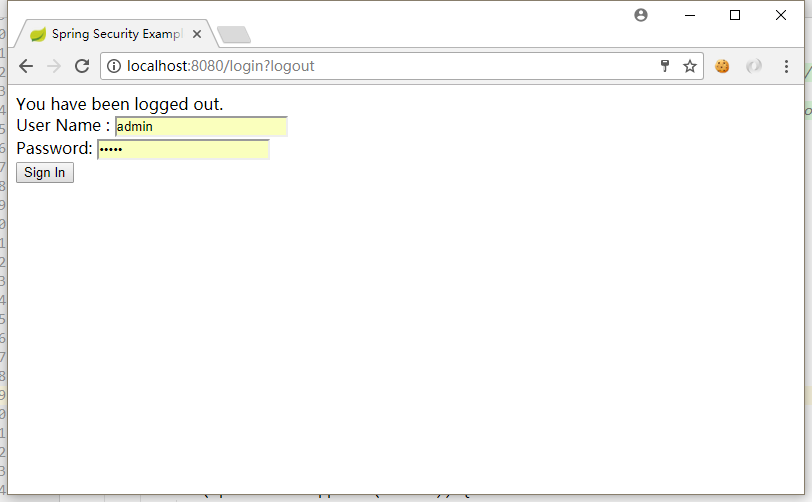摘要: 原创出处 https://www.cnkirito.moe/spring-security-2/ 「老徐」欢迎转载,保留摘要,谢谢!
上一篇文章《Spring Security(一)–Architecture Overview》,我们介绍了Spring Security的基础架构,这一节我们通过Spring官方给出的一个guides例子,来了解Spring Security是如何保护我们的应用的,之后会对进行一个解读。
2 Spring Security Guides
2.1 引入依赖
1 <dependencies> 2 <dependency> 3 <groupId>org.springframework.boot</groupId> 4 <artifactId>spring-boot-starter-web</artifactId> 5 </dependency> 6 <dependency> 7 <groupId>org.springframework.boot</groupId> 8 <artifactId>spring-boot-starter-security</artifactId> 9 </dependency> 10 <dependency> 11 <groupId>org.springframework.boot</groupId> 12 <artifactId>spring-boot-starter-thymeleaf</artifactId> 13 </dependency> 14 </dependencies>
2.2 创建一个不受安全限制的web应用由于我们集成了springboot,所以不需要显示的引入Spring Security文档中描述core,config依赖,只需要引入spring-boot-starter-security即可。
这是一个首页,不受安全限制
src/main/resources/templates/home.html
1 <!DOCTYPE html> 2 <html xmlns="http://www.w3.org/1999/xhtml" xmlns:th="http://www.thymeleaf.org" xmlns:sec="http://www.thymeleaf.org/thymeleaf-extras-springsecurity3"> 3 <head> 4 <title>Spring Security Example</title> 5 </head> 6 <body> 7 <h1>Welcome!</h1> 8 9 <p>Click <a th:href="@{/hello}">here</a> to see a greeting.</p> 10 </body> 11 </html>
src/main/resources/templates/hello.html这个简单的页面上包含了一个链接,跳转到”/hello”。对应如下的页面
1 <!DOCTYPE html> 2 <html xmlns="http://www.w3.org/1999/xhtml" xmlns:th="http://www.thymeleaf.org" 3 xmlns:sec="http://www.thymeleaf.org/thymeleaf-extras-springsecurity3"> 4 <head> 5 <title>Hello World!</title> 6 </head> 7 <body> 8 <h1>Hello world!</h1> 9 </body> 10 </html>
1 @Configuration 2 public class MvcConfig extends WebMvcConfigurerAdapter { 3 4 @Override 5 public void addViewControllers(ViewControllerRegistry registry) { 6 registry.addViewController("/home").setViewName("home"); 7 registry.addViewController("/").setViewName("home"); 8 registry.addViewController("/hello").setViewName("hello"); 9 registry.addViewController("/login").setViewName("login"); 10 } 11 12 }
2.3 配置Spring Security接下来配置Spring MVC,使得我们能够访问到页面。
一个典型的安全配置如下所示:
1 @Configuration 2 @EnableWebSecurity <1> 3 public class WebSecurityConfig extends WebSecurityConfigurerAdapter { <1> 4 @Override 5 protected void configure(HttpSecurity http) throws Exception { 6 http <2> 7 .authorizeRequests() 8 .antMatchers("/", "/home").permitAll() 9 .anyRequest().authenticated() 10 .and() 11 .formLogin() 12 .loginPage("/login") 13 .permitAll() 14 .and() 15 .logout() 16 .permitAll(); 17 } 18 19 @Autowired 20 public void configureGlobal(AuthenticationManagerBuilder auth) throws Exception { 21 auth <3> 22 .inMemoryAuthentication() 23 .withUser("admin").password("admin").roles("USER"); 24 } 25 }
<2> configure(HttpSecurity)定义了哪些URL路径应该被拦截,如字面意思所描述:”/“, “/home”允许所有人访问,”/login”作为登录入口,也被允许访问,而剩下的”/hello”则需要登陆后才可以访问。<1> @EnableWebSecurity注解使得SpringMVC集成了Spring Security的web安全支持。另外,WebSecurityConfig配置类同时集成了WebSecurityConfigurerAdapter,重写了其中的特定方法,用于自定义Spring Security配置。整个Spring Security的工作量,其实都是集中在该配置类,不仅仅是这个guides,实际项目中也是如此。
<3> configureGlobal(AuthenticationManagerBuilder)在内存中配置一个用户,admin/admin分别是用户名和密码,这个用户拥有USER角色。
我们目前还没有登录页面,下面创建登录页面:
1 <!DOCTYPE html> 2 <html xmlns="http://www.w3.org/1999/xhtml" xmlns:th="http://www.thymeleaf.org" 3 xmlns:sec="http://www.thymeleaf.org/thymeleaf-extras-springsecurity3"> 4 <head> 5 <title>Spring Security Example </title> 6 </head> 7 <body> 8 <div th:if="${param.error}"> 9 Invalid username and password. 10 </div> 11 <div th:if="${param.logout}"> 12 You have been logged out. 13 </div> 14 <form th:action="@{/login}" method="post"> 15 <div><label> User Name : <input type="text" name="username"/> </label></div> 16 <div><label> Password: <input type="password" name="password"/> </label></div> 17 <div><input type="submit" value="Sign In"/></div> 18 </form> 19 </body> 20 </html>
最后,我们为hello.html添加一些内容,用于展示用户信息。这个Thymeleaf模板提供了一个用于提交用户名和密码的表单,其中name=”username”,name=”password”是默认的表单值,并发送到“/ login”。 在默认配置中,Spring Security提供了一个拦截该请求并验证用户的过滤器。 如果验证失败,该页面将重定向到“/ login?error”,并显示相应的错误消息。 当用户选择注销,请求会被发送到“/ login?logout”。
<!DOCTYPE html> <html xmlns="http://www.w3.org/1999/xhtml" xmlns:th="http://www.thymeleaf.org" xmlns:sec="http://www.thymeleaf.org/thymeleaf-extras-springsecurity3"> <head> <title>Hello World!</title> </head> <body> <h1 th:inline="text">Hello [[${#httpServletRequest.remoteUser}]]!</h1> <form th:action="@{/logout}" method="post"> <input type="submit" value="Sign Out"/> </form> </body> </html>
2.4 添加启动类我们使用Spring Security之后,HttpServletRequest#getRemoteUser()可以用来获取用户名。 登出请求将被发送到“/ logout”。 成功注销后,会将用户重定向到“/ login?logout”。
@SpringBootApplication public class Application { public static void main(String[] args) throws Throwable { SpringApplication.run(Application.class, args); } }
访问首页http://localhost:8080/:2.5 测试
点击here,尝试访问受限的页面:/hello,由于未登录,结果被强制跳转到登录也/login:
输入正确的用户名和密码之后,跳转到之前想要访问的/hello:
点击Sign out退出按钮,访问:/logout,回到登录页面:
Spring Security 无法登陆,报错:There is no PasswordEncoder mapped for the id “null”
网上百度了一下发现这是因为Spring security 5.0中新增了多种加密方式,也改变了密码的格式。
要想我们的项目还能够正常登陆,需要修改一下configure中的代码。我们要将前端传过来的密码进行某种方式加密,spring security 官方推荐的是使用bcrypt加密方式。那么如何对密码加密呢,只需要在configure方法里面指定一下。
修改后是这样的:
protected void configure(AuthenticationManagerBuilder auth) throws Exception { //inMemoryAuthentication 从内存中获取 auth.inMemoryAuthentication().passwordEncoder(new BCryptPasswordEncoder()).withUser("user1").password(new BCryptPasswordEncoder().encode("123456")).roles("USER"); }
在inMemoryAuthentication()后面多了".passwordEncoder(new BCryptPasswordEncoder())",这相当于登陆时用BCrypt加密方式对用户密码进行处理。以前的".password("123456")" 变成了 ".password(new BCryptPasswordEncoder().encode("123456"))" ,这相当于对内存中的密码进行Bcrypt编码加密。比对时一致,说明密码正确,允许登陆。
如果你现在用的也是从内存中取密码,那么按照上面这么修改后应该会成功登录没有问题的。
如果你用的是在数据库中存储用户名和密码,那么一般是要在用户注册时就使用BCrypt编码将用户密码加密处理后存储在数据库中。并且修改configure()方法,加入".passwordEncoder(new BCryptPasswordEncoder())",保证用户登录时使用bcrypt对密码进行处理再与数据库中的密码比对。如下:
//注入userDetailsService的实现类 auth.userDetailsService(userService).passwordEncoder(new BCryptPasswordEncoder());



